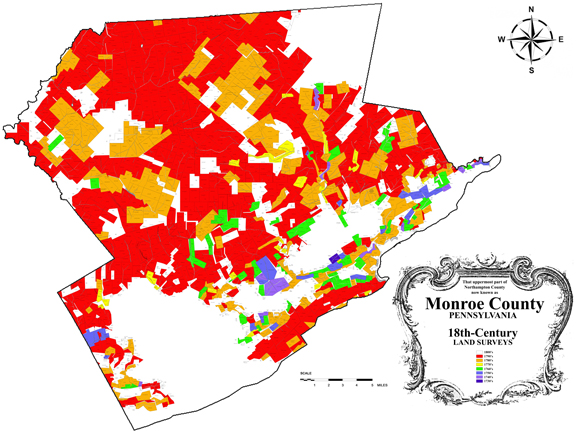While the cost of purchasing land in Penn's Woods
was long touted by the Proprietaries as being
reasonably inexpensive --
the purchase price for 100 acres of land at fifteen
pounds ten shillings -- that cost still represented
more than half a year's wages for the average
laborer.
So, did our local settlers grudgingly pay for the
land, or did they instead manage to find some kind
of work-around solution? As it turns
out, there were many in our upper Northampton County
region who took it upon themselves to locate and
"improve" a vacant tract of land without obtaining
any warrant whatsover for the land. They
paid absolutely nothing. Zero. Zip. Nada. In
other words, our initial area residents were more
than quite comfortable being "squatters".
In time, Pennsylvania officials began to recognize
the lay of the land and adopted measures designed to
counteract this deleterious trend.
Accordingly, land policy shifted in 1765, permitting
settlers who had squatted on unwarranted land, and
who were willing to accept the results of a land
survey, to be granted an official warrant for their
land, upon application. This resulted in the
creation of the registry of "East Side" Applications
(corresponding to land on the East side of the
Susquehanna River), through which the warrantee was
granted an official Pennsylvania warrant, agreed to
abide by the subsequent land survey, and pay the
original purchase price of the property, with back
interest.
While still not an overly advantageous real estate
deal,
160 such East Side Applications were ultimately
tendered within the boundaries of today's
Monroe County, ...and yet the county
still remained barely settled.
What was clear was that full-tilt area settlement
would not occur until land prices dropped
dramatically. This finally happened after the
passage of the Vacant Land Law of 1792 that saw the
cost of land acquisition drop to record low levels:
| |
That from and after the passing of this act,
the price of all the vacant lands within the
limits of the purchase made of the Indians
in the year one thousand seven hundred and
sixty-eight, and all preceding purchases,
excepting always such lands as have been
previously settled upon or improved, shall
be reduced to the sum of fifty shillings for
every hundred acres. |
|
Shown in red below is the explosion of settlement
that occurred after the passage of this law (with
tract sizes often exceeeding 400 acres):
[apologies, map is not yet complete].
